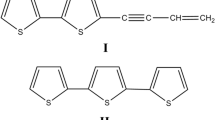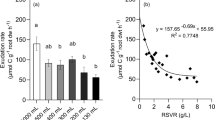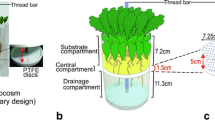Abstract
Understanding allelopathy has been hindered by the lack of methods available to monitor the dynamics of allelochemicals in the soil. Previous work has demonstrated the feasibility of using polydimethylsiloxane (PDMS) microtubing (silicone tubing microextraction, or STME) to construct sampling devices to monitor the release of lipophilic allelochemicals from plant roots. The objective of this study was to use such sampling devices to intensively monitor thiophene fluxes beneath marigolds over several weeks to gain insight into the magnitude of temporal and spatial heterogeneity in these fluxes. Marigolds were grown in rhizoboxes (20.5 x 20.5 x 3.0 cm) with 16 individual STME samplers per box. Thiophene sampling and HPLC analysis began 45 days after planting. At the end of the study, roots around each sampler were analyzed by HPLC. Results confirmed the tremendous spatial and temporal heterogeneity in thiophene production seen in our previous studies. STME probes show that thiophene concentrations generally increase over time; however, these effects were sampling-port specific. When sampling ports were monitored at 12 h intervals, fluxes at each port ranged from 0 to 2,510 ng day−1. Fluxes measured over daylight hr averaged 29 % higher than those measured overnight. Fluxes were less than 1 % on average of the total thiophene content of surrounding roots. While the importance of such heterogeneity, or “patchiness”, in the root zone has been recognized for soil nutrients, the potential importance in allelopathic interactions has seldom been considered. The reasons for this variability are unclear, but are being investigated. Our results demonstrate that STME can be used as a tool to provide a more finely-resolved picture of allelochemical dynamics in the root zone than has previously been available.







Similar content being viewed by others
References
Barto K, Cipollini D (2009) Half-lives and field soil concentrations of Alliaria petiolata secondary metabolites. Chemosphere 76:71–75
Barto EK, Hilker M, Müller F, Mohney BK, Weidenhamer JD, Rillig MC (2011) The fungal fast lane: common mycorrhizal networks extend bioactive zones of allelochemicals in soils. PLoS One 6:e27195
Barto EK, Weidenhamer JD, Cipollini D, Rillig MC (2012) Fungal superhighways: do common mycorrhizal networks enhance below ground communication? Trends Plant Sci 17:633–637
Belz RG, Hurle K (2005) Differential exudation of two benzoxazinoids one of the determining factors for seedling allelopathy of triticaceae species. J Agric Food Chem 53:250–261
Blum U (2011) Plant-plant interactions: phenolic acids, cover crops, and weed emergence. Springer Science and Business Media, Dordrecht
Campbell G, Lambert J, Arnason JT, Towers GHN (1982) Allelopathic properties of α-terthienyl and phenylheptatriyne, naturally occurring compounds from species of Asteraceae. J Chem Ecol 8:961–972
Campbell BD, Grime JP, Mackey JML, Jalili A (1991) A trade-off between scale and precision in resource foraging. Oecologia 87:532–538
Darrah PR (1991) Models of the rhizosphere. Plant Soil 133:187–199
Dayan FE, Howell J, Weidenhamer JD (2009) Dynamic root exudation of sorgoleone and its in planta mechanism of action. J Exp Bot 60:2107–2117
DE Scisciolo B, Leopold DJ, Walton DC (1990) Seasonal patterns of juglone in soil beneath Juglans nigra (black walnut) and influence of J. nigra on understory vegetation. J Chem Ecol 16:1111–1130
Ens EJ, French K, Bremner JB, Korth J (2010) Novel technique shows different hydrophobic chemical signatures of exotic and indigenous plant soils with similar effects of extracts on indigenous species seedling growth. Plant Soil 326:403–414
Evenhuis A, Korthals G, Molendijk L (2004) Tagetes patula as an effective catch crop for long-term control of Pratylenchus penetrans. Nematol 6:877–881
Gouliarmou V, Mayer P (2012) Sorptive bioaccessibility extraction (SBE) of soils: combining a mobilization medium with an absorption sink. Environ Sci Technol 46:10682–10689
Gouliarmou V, Collins CD, Christiansen E, Mayer P (2013) Sorptive physiologically based extraction of contaminated solid matrices: incorporating silicone rod as absorption sink for hydrophobic organic contaminants. Environ Sci Technol 47:941–948
Gross K, Peters A, Pregitzer KS (1993) Fine root growth and demographic responses to nutrient patches in four old-field plant species. Oecologia 95:61–64
Hierro JL, Maron JL, Callaway RM (2005) A biogeographical approach to plant invasions: the importance of studying exotics in their introduced and native range. J Ecol 93:5–15
Hinsinger P, Gobran GR, Gregory PJ, Wenzel WW (2005) Rhizosphere geometry and heterogeneity arising from root-mediated physical and chemical processes. New Phytol 168:293–303
Hinsinger P, Brauman A, Devau N, Gérard F, Jourdan C, J-P L, LE Cadre E, Jaillard B, Plassard C (2011) Acquisition of phosphorus and other poorly mobile nutrients by roots. where do plant nutrition models fail? Plant Soil 348:29–61
Inderjit, Wardle DA, Karban R, Callaway RM (2011) The ecosystem and evolutionary contexts of allelopathy. Trends Ecol Evol 26:655–662
Inselsbacher E, Öhlund J, Jämtgård S, Huss-danell K, Näsholm T (2011) to monitor organic and inorganic nitrogen compounds in soil. Soil Biol Biochem 43:1321–1332
Hnke A, Mayer P, Mclachlan MS (2012) Sensitive equilibrium sampling to study polychlorinated biphenyl disposition in Baltic Sea sediment. Environ Sci Technol 46:10114–10122
Jessing KK, Cedergreen N, Mayer P, Libous-bailey L, STROBE BW, Rimando A, Duke SO (2013) Loss of artemisinin produced by Artemisia annua L. to the soil environment. Ind Crop Prod 43:132–140
Lambers H, Shane MW, Cramer MD, Pearse SJ, Veneklaas EJ (2006) Root structure and functioning for efficient acquisition of phosphorus: matching morphological and physiological traits. Ann Bot 98:693–713
Lehman ME, Blum U, Gerig TM (1994) Simultaneous effects of ferulic andp-coumaric acids on cucumber leaf expansion in split-root experiments. J Chem Ecol 20:1773–1782
Lyu SW, Blum U (1990) Effects of ferulic acid, an allelopathic compound, on net P, K, and water uptake by cucumber seedlings in a split-root system. J Chem Ecol 16:2429–2439
Mohney BK, Matz T, Lamoreaux J, Wilcox DS, Gimsing AL, Mayer P, Weidenhamer JD (2009) In situ silicone tube microextraction: a new method for undisturbed sampling of root-exuded thiophenes from marigold (Tagetes erecta L.) in soil. J Chem Ecol 35:1279–1287
Muscolo A, Sidari M (2006) Seasonal fluctuations in soil phenolics of a coniferous forest: effects on seed germination of different coniferous species. Plant Soil 284:305–318
Passioura JB (1991) Soil structure and plant growth. Soil Res 29:717–728
Poli F, Sacchetti G, Bruni A (1995) Distribution of internal secretory structures in Tagetes patula (Asteraceae). Nord J Bot 15:197–205
Rudolph N, Voss S, Moradi AB, Nagl S, Oswald SE (2013) Spatio-temporal mapping of local soil pH changes induced by roots of lupin and soft-rush. Plant Soil 269:669–680
Sacchetti G, Romagnoli C, Bruni A, Poli F (2001) Secretory tissue ultrastructure in Tagetes patula L. (Asteraceae) and thiophene localization through X-ray microanalysis. Phyton 41:35–48
San emeterio L, Damgaard C, Canals RM (2007) Modelling the combined effect of chemical interference and resource competition on the individual growth of two herbaceous populations. Plant Soil 292:95–103
Sinkkonen A (2007) Modelling the effect of autotoxicity on density-dependent phytotoxicity. J Theor Biol 244:218–227
Tharayil N, Triebwasser DJ (2010) Elucidation of a diurnal pattern of catechin exudation by Centaurea stoebe. J Chem Ecol 36:200–204
Tharayil N, Bhowmik P, Alpert P, Walker E, Amarasiriwardena D, Xing B (2009) Dual purpose secondary compounds: phytotoxin of Centaurea diffusa also facilitates nutrient uptake. New Phytol 181:424–434
Thorpe AS, Thelen GC, Diaconu A, Callaway RM (2009) Root exudate is allelopathic in invaded community but not in native community: field evidence for the novel weapons hypothesis. J Ecol 97:641–645
Wardle DA, Karban R, Callaway RM (2011) The ecosystem and evolutionary contexts of allelopathy. Trends Ecol Evol 26:655–662
Weidenhamer JD (2005) Biomimetic measurement of allelochemical dynamics in the rhizosphere. J Chem Ecol 31:221–236
Weidenhamer JD (2007) New approaches to analyse allelochemicals in soil. Allelopathy J 19:135–142
Weidenhamer JD, Romeo JT (1989) Allelopathic properties of Polygonella myriophylla. J Chem Ecol 15:1957–1970
Weidenhamer JD, Boes PD, Wilcox DS (2009) Solid-phase root zone extraction (SPRE): a new methodology for measurement of allelochemical dynamics in soil. Plant Soil 322:177–186
Williamson GB, Weidenhamer JD (1990) Bacterial degradation of juglone. J Chem Ecol 16:1739–1742
Acknowledgements
Evan Dort assisted with rhizobox construction and establishment of the experiment. Margaret McCully provided advice on microscopy techniques. Udo Blum provided helpful comments on experimental design and on the manuscript, and two anonymous reviewers provided helpful comments which improved the manuscript.
Author information
Authors and Affiliations
Corresponding author
Electronic supplementary material
Below is the link to the electronic supplementary material.
ESM 1
(DOC 71 kb)
Rights and permissions
About this article
Cite this article
Weidenhamer, J.D., Mohney, B.K., Shihada, N. et al. Spatial and Temporal Dynamics of Root Exudation: How Important is Heterogeneity in Allelopathic Interactions?. J Chem Ecol 40, 940–952 (2014). https://doi.org/10.1007/s10886-014-0483-4
Received:
Revised:
Accepted:
Published:
Issue Date:
DOI: https://doi.org/10.1007/s10886-014-0483-4




